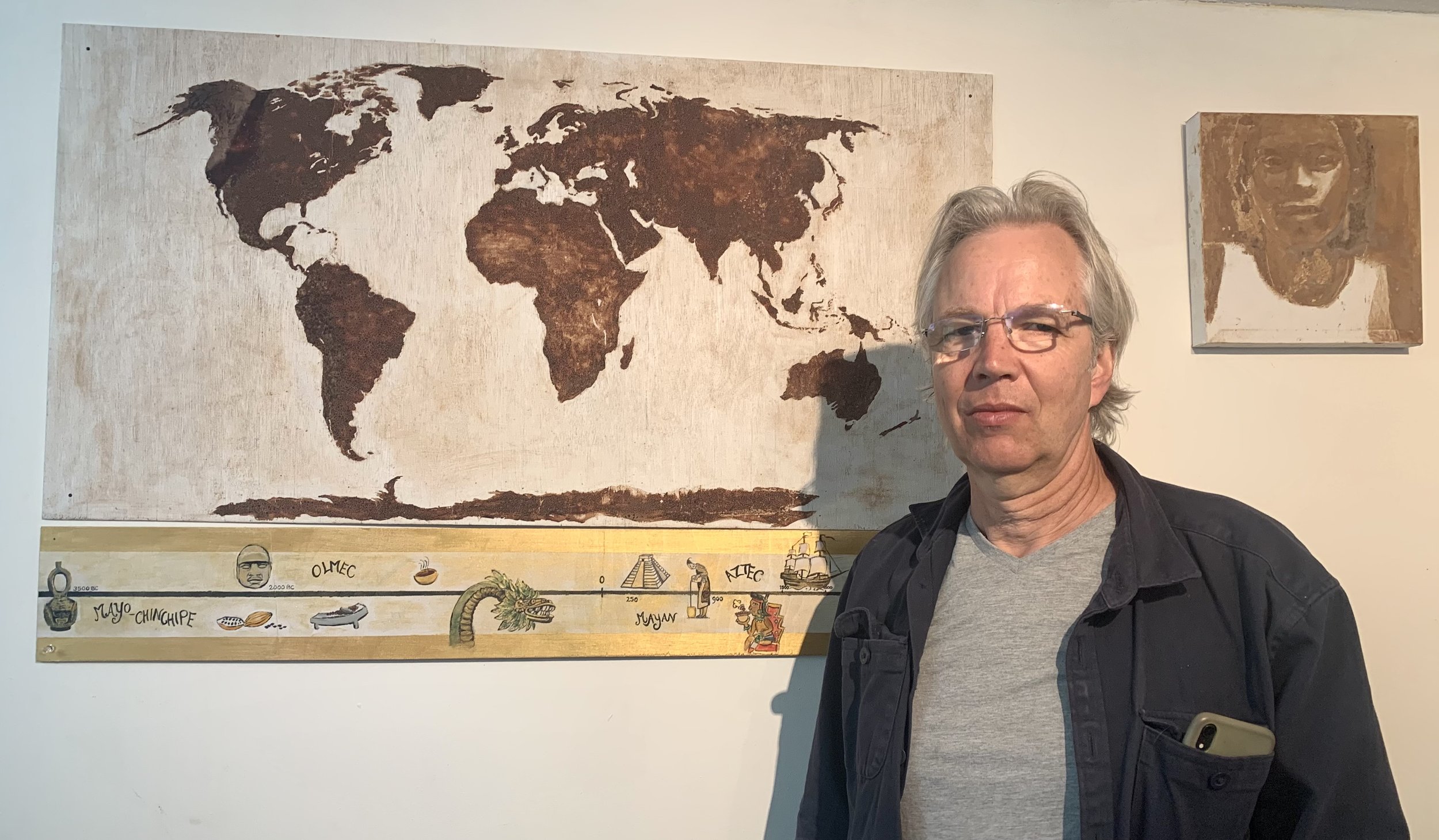Why the Amsterdam Cacao Museum is a Must Visit for Chocolate Lovers
Single origin Madagascar chocolates photo credit Anna Mindess
The Amsterdam Cacao Museum is many things—a history museum, a place for classes and tastings and a shop where you can buy chocolate, but not just any chocolate. The chocolate bars on display at the petite museum may not be ones you recognize. Their intriguing collection includes dozens of bars that are all single-origin, bean-to-bar, and direct trade, hailing from countries including Madagascar, Belize, Peru, Brazil, and Uganda. The museum offers over 100 bars including bars from Pacari, Marou, Original Beans, and Auro.
Chocolate with a Mission
Henkjan Laats and world painted in chocolate photo credit Anna Mindess
Meeting the museum’s owner, Henkjan Laats, a professorial-looking gentleman who holds a PhD in conflict transformation, it may seem surprising that he was destined to open a chocolate museum in Amsterdam, but the 25 years he spent living and working in Latin America, Asia (including Nepal) prepared him to do just that.
Since 2020, Laats has worked with the UN’s Harmony with Nature program, which has as one of its goals to: “recognize the rights of nature in the context of the promotion of sustainable development.” And 20 years ago, he founded Cross Cultural Bridges, an organization with similar goals that sponsors projects such as International Chocolate School, which provides “an innovative educational program unique for Latin America to reactivate and strengthen cocoa and chocolate food chains.”
Laats says the Cacao Museum, which he opened in 2017, is a result of his two passions: fine flavor and the conservation of rain forests. “The nice thing for me is that a cacao museum can be the starting point for many stories about Indigenous people, about the rain forests, about good food. The point is not to sell more chocolate, but better chocolate. That means made in the country where it was grown. And I want to have as many countries represented as possible because it’s a museum.”
Another important value for Laats is avoiding waste. “Only 15% of the cacao pod is used for chocolate, so 85% is wasted” he says, “but it can be used to make other things: I’ve made list of 25 products that use cacao juice, including tea, toothpaste, cacao beer, bread flour, cheese, sausages and jam.”
Painting with Chocolate class credit Cacao Museum
Classes and Tastings
Even though he is serious about chocolate, Laats offers several classes where he wants his students to have fun as well as learn. In Chocolate Tastings, he uses the colorful Chocolate Tasting Flavour Map for discussion, then asks participants to paint their reactions on little post-its.
In his Chocolate Pairing class, after a cup of cacao tea and a tour of the museum, students pair chocolate with products such as wine, beer, coffee, tea, rum, cheese, and whiskey.
And for a unique experience, students create their own paintings in his Painting with Chocolate class.
Since Laats also worked as a chef 35 years ago, he sometimes prepares an entire dinner based on chocolate. Recently, he created fine chocolate-based recipes in magazines for dishes such as Peruvian ceviche with white chocolate and lemon, and duck with chocolate, wine, and cherries.
History of Chocolate
Cacao bean exhibit photo credit Anna Mindess
Downstairs is the compact chocolate museum, with exhibits on the history of chocolate. Laats keeps it small and says, “20-30 min of history is enough.”
Films and exhibits describe the history of the cacao industry starting with the Mayo Chincipe culture from South Ecuador, 6000 years ago. Cacao came to the Netherlands from all over the world. And Amsterdam played a crucial role, as the home of Coenraad Van Houten, who invented the cacao press in Amsterdam in 1828 which revolutionized the way cocoa was processed. Coincidentally, Czaar Peterstraat, the street the museum is on, became the largest cocoa port in the world and a center for sailors.
Antique cocoa tins photo credit Anna Mindess
Laats stresses the importance of the Van Houten family. “They were creative entrepreneurs who were the inventors of the cacao press. In essence, they invented cocoa. ‘Dutching’ is still the name of process. They are the roots of everything in commercial chocolate. It is the reason why still so many cacao companies are still located in the Netherlands, which is still the biggest cacao processing area. Without the Van Hootens, it would never have happened.” Read more about Dutch process cocoa powder.
Laat’s last word: “The museum is not fancy, our tastings are very reasonable, I want to make it accessible to everyone, so everyone can get this information.”





